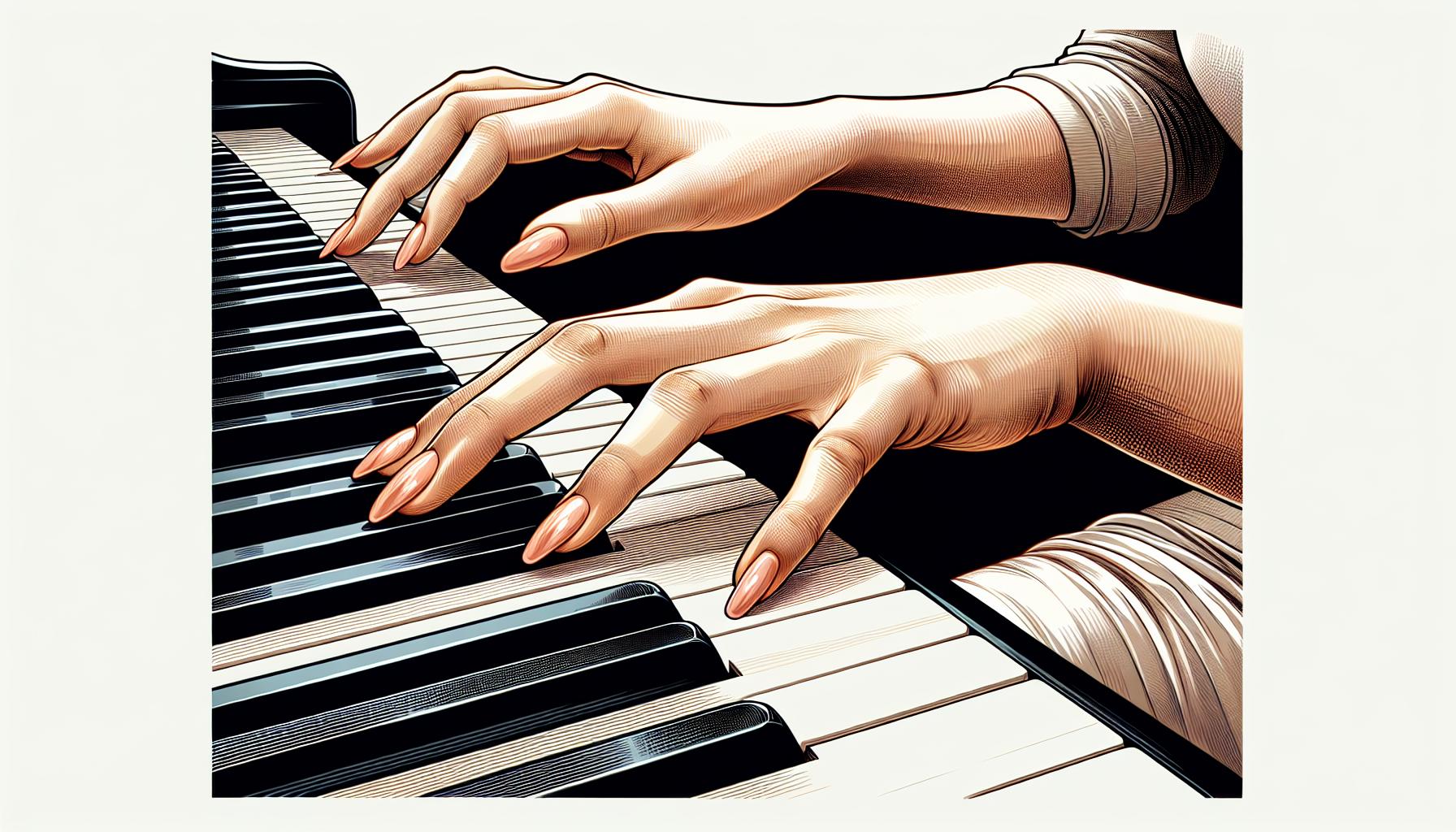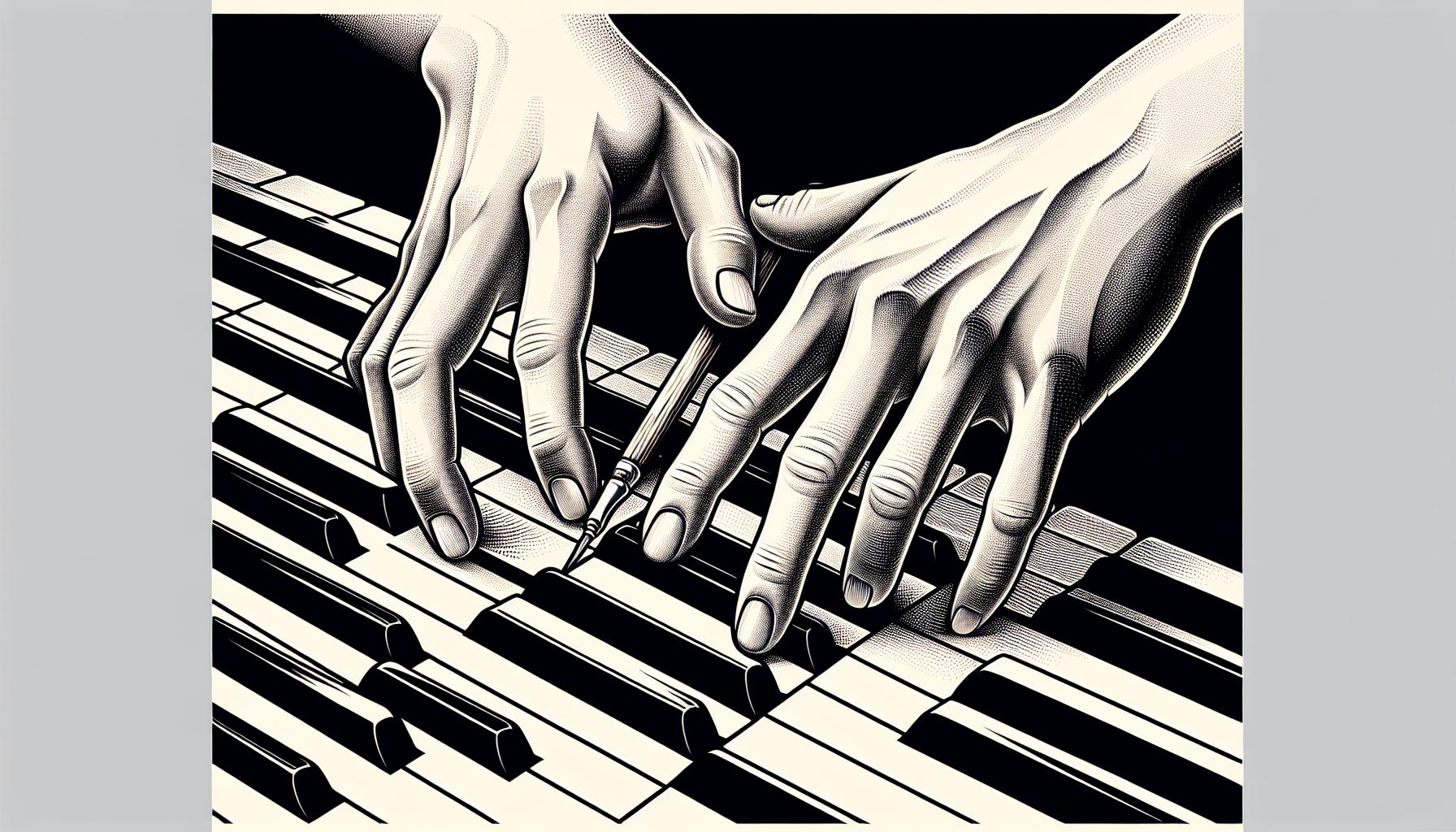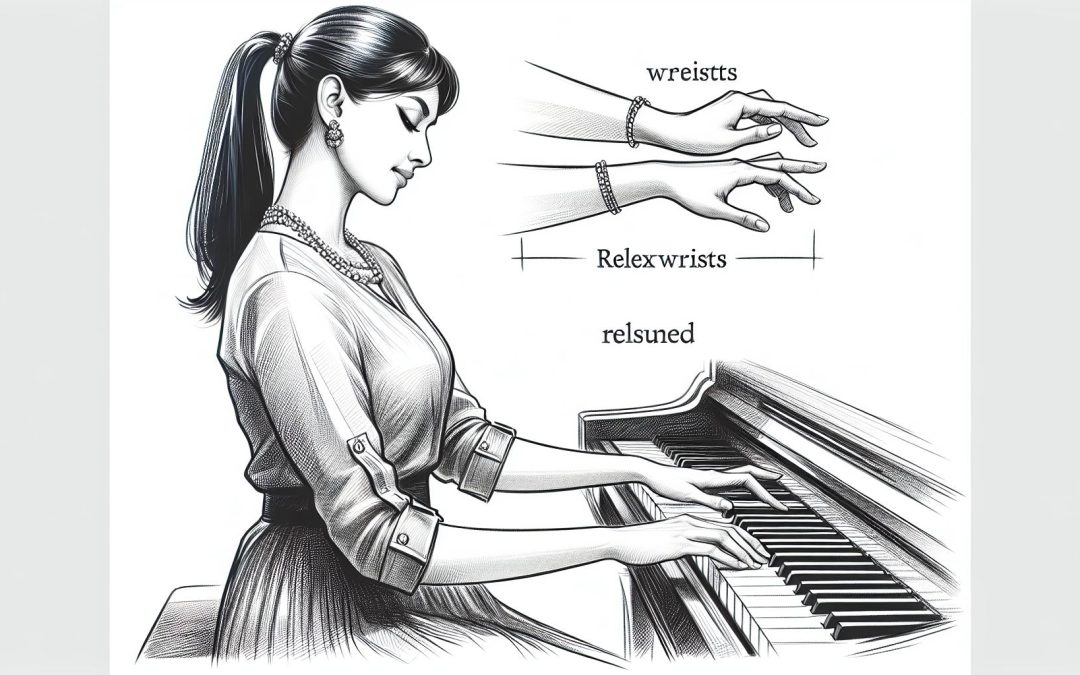Playing the piano beautifully isn't just about hitting the right notes; it's also about how you hit them. One key element that often goes overlooked is the importance of having relaxed wrists. It's a simple concept that can make a world of difference in your playing, transforming stiff, robotic movements into smooth, expressive passages.
Many pianists, from beginners to the more experienced, find themselves struggling with tension in their wrists, which can lead to discomfort and even injury over time. But don't worry, mastering the art of playing with relaxed wrists is within reach. With a few adjustments and mindful practice, anyone can learn to play more fluidly and comfortably.
The Importance of Relaxed Wrists in Piano Playing
When it comes to the delicate art of piano playing, the wrists play a pivotal role that's often understated. They're not just a bridge connecting the fingers to the rest of the arm; they are instrumental in creating the flowing, effortless sound that defines expert playing. Maintaining relaxed wrists is not merely a suggestion but a crucial element in achieving both the technical and expressive qualities that music demands.
One of the main reasons relaxed wrists are so important is their impact on dynamics and expression. Firm, rigid wrists limit the range of motion, making it difficult to execute soft, flowing passages or powerful, emphatic chords with the same ease. In contrast, relaxed wrists can move freely, allowing for nuanced control over the volume and quality of each note.
Furthermore, the health and longevity of a pianist's career can heavily depend on their ability to play without tension. Chronic tension can lead to discomfort and, more severely, repetitive strain injuries such as tendinitis or carpal tunnel syndrome. These conditions not only cause pain but can also necessitate breaks from playing or, in extreme cases, lead to the end of a pianist's playing days. By fostering relaxation in the wrists, players can significantly reduce their risk of these injuries, ensuring they can continue to enjoy playing for years to come.
| Risk Factor | Without Relaxed Wrists | With Relaxed Wrists |
|---|---|---|
| Dynamics and Expression | Limited | Enhanced |
| Risk of Injury | High | Reduced |
To cultivate relaxed wrists, it's essential to begin with proper posture and hand positioning at the piano. The forearms should be roughly parallel to the floor, with the wrists neither drooping down nor arched too high. This neutral position promotes natural, fluid movements and reduces tension. Additionally, incorporating specific exercises and stretches into one's practice routine can further develop wrist flexibility and strength, making it easier to maintain relaxation even during challenging pieces.
Mindful practice is another key component. Players should regularly check in with their bodies, ensuring they're not holding unnecessary tension in the wrists or elsewhere. Sometimes, tension can creep in without notice, especially when focusing intently on learning a new piece or perfecting a difficult passage. By staying aware and making adjustments as needed, pianists can gradually train themselves to play more relaxedly.
Common Issues with Tension in Wrists

Playing the piano requires not just intellectual acumen but also physical harmony, particularly in one's wrists. However, many pianists, from beginners to seasoned professionals, encounter issues related to wrist tension. Understanding these problems is the first step toward achieving the goal of playing with relaxed wrists.
Impact on Musicality
Firstly, wrist tension significantly hampers musical expression. A relaxed wrist allows for better control over dynamics, enabling pianists to produce a wide range of volumes and tones. In contrast, a tense wrist results in a played note or chord sounding flat or forced, stripping the music of its intended emotional impact.
Risk of Injury
Secondly, the risk of injury escalates with continuous wrist tension. Tendinitis and carpal tunnel syndrome are common conditions among pianists who don't adopt relaxed wrist techniques. These injuries not only cause pain and discomfort but can also lead to prolonged periods away from the piano, hindering progress and growth as a musician.
| Condition | Description | Prevalence Among Pianists |
|---|---|---|
| Tendinitis | Inflammation of the tendon due to overuse or strain. | High |
| Carpal Tunnel Syndrome | Compression of the nerve within the carpal tunnel, leading to numbness and tingling in the hand. | Moderately High |
Hindrance to Technical Development
Moreover, tension in the wrists acts as a roadblock to technical advancement. Techniques such as scales, arpeggios, and octave jumps require fluidity and flexibility which can't be achieved if the wrists are stiff. This limitation not only affects a pianist's ability to execute complex pieces but also slows down the learning process overall.
Psychological Effects
The psychological aspect of playing with wrist tension cannot be overlooked. Frustration and a lack of confidence often accompany the inability to play as expressively or accurately as desired. Over time, this can lead to a diminishing passion for playing, as every practice session or performance becomes a reminder of the physical limitations being faced.
- Mindful Practice: Incorporating mindfulness into practice sessions helps in recognizing when and where tension occurs.
- Proper Posture and Hand Positioning: Ensuring the correct posture and hand positioning lays the foundation for relaxed wrists.
- Stretching and Strengthening Exercises: Regular exercises designed
Techniques for Playing Piano with Relaxed Wrists

Relaxed wrists are integral for pianists, not just for improving the quality of their music but also for preventing injuries that can sideline their passion. Achieving and maintaining this relaxed state, however, requires a conscious effort and a set of techniques that should become second nature over time.
One fundamental approach is to Always Start with Proper Posture. The height of the piano bench and the distance from the keyboard are crucial. They should sit in such a way that their forearms are parallel to the floor when playing. This position promotes wrist relaxation and allows for better control and flexibility.
Mindful Practice Sessions play a critical role in developing relaxed wrists. Pianists should start their sessions with the intention of keeping their wrists loose. This involves being acutely aware of their body's tension and consciously relaxing their wrists as they play. Incorporating slow practice pieces specifically focusing on wrist movement can significantly improve flexibility and relaxation.
Hand Positioning and Movements are also key. Fingers should curve naturally, allowing the hand to form a rounded shape over the keys. This encourages the wrist to stay flexible. Pianists should avoid flat-fingered playing, which often leads to tension. Instead, they should aim for a fluid motion from their fingers through their wrists, as if lightly bouncing off the keys with each note.
Exercises aimed at Strengthening and Stretching the wrists can't be overlooked. Interval training, where intense periods of playing are followed by rest and stretching exercises, helps in muscle recovery and flexibility. Simple stretches, like gently bending the wrist forwards and backwards or rotating them in circles, can be immensely beneficial if done consistently before and after practice sessions.
Incorporating Dynamic Playing into Practice routines is another essential technique. Dynamic playing involves varying the volume and intensity of the music, which in turn, requires a pianist to adjust their touch and wrist tension. By practicing pieces with varying dynamics, pianists can learn how to fluidly adjust their wrist tension, thus enhancing their ability to maintain relaxed wrists across all playing styles.
Lastly, Breaks are Essential. No matter how immersed one gets in the music, taking regular breaks to rest and reset the wrists is crucial. Short breaks during practice sessions give the muscles time to relax and reduce built-up tension. This not only helps in maintaining relaxed wrists but also in preventing fatigue and injuries.
Exercises to Help Relax and Strengthen Wrist Muscles

Playing the piano with relaxed wrists isn't just about avoiding stiffness during performances; it’s also about strengthening the muscles around the wrists to support fluid, graceful movements. Incorporating specific exercises into daily practice can significantly enhance both the flexibility and strength of a pianist's wrists, making playing more enjoyable and reducing the risk of injury.
Stretching Exercises
Stretching is essential for maintaining wrist flexibility. These simple exercises can be done before and after practice sessions:
- Wrist Rotations: Extend the arms in front with palms down. Gently rotate the wrists clockwise, then counterclockwise, 10 times in each direction. This exercise promotes joint mobility.
- Palm Pushes: With palms facing each other in front of the chest, gently push the palms together while keeping the elbows out to the sides. Hold for 5-10 seconds, then release. This stretch works on the muscles and tendons that run across the back of the hand and forearm.
- Finger Stretches: Extend one arm out with the palm facing up and gently pull back on the fingers with the opposite hand, stretching the underside of the forearm. Hold for 15 seconds, then switch hands.
Strengthening Exercises
To complement flexibility, developing strength in the wrists and forearms is crucial. Here are exercises geared toward building that necessary muscle:
- Wrist Curls: Using a light weight (a small dumbbell or a can of food), sit with the forearm on the thigh, palm facing up. Curl the weight towards the body, then lower it back down. Aim for 2 sets of 12-15 reps on each side.
- Reverse Wrist Curls: Similar to wrist curls, but with the palm facing down. This exercise targets the extensor muscles on the back of the forearm. Again, aim for 2 sets of 12-15 reps on each side.
- Grip Strengthening: Squeeze a stress ball or a grip strengthener for 5-10 seconds, then release. Repeat 10 times. This simple exercise improves grip strength and endurance, essential for pianists.
Tips for Maintaining Relaxed Wrists While Playing

Maintaining relaxed wrists is crucial for pianists who wish to play gracefully and avoid injury. Several strategies can help achieve this, ensuring long-term comfort and performance quality.
Proper Posture and Bench Positioning play pivotal roles in facilitating wrist relaxation. Sitting at the correct height so that the forearms are parallel to the floor allows the wrists to remain loose and fluid. Adjusting the bench so that it's neither too close nor too far from the keyboard is equally important. This optimal positioning supports the natural curvature of the hands and prevents excessive strain.
Incorporating Mindful Practice Sessions into one's routine is another effective strategy. Being conscious of the tension in the wrists while playing can help identify bad habits that may lead to stress and strain. Musicians should take frequent breaks during practice to stretch and relax the wrists. These pauses not only reduce the likelihood of injury but also enhance focus and performance.
Technique refinement is essential for maintaining relaxed wrists. Developing a touch that's light and responsive, rather than heavy and forceful, can significantly reduce tension. Techniques such as the drop-roll method, where the pianist allows the weight of the arm to fall onto the keys and rolls the wrist gently with each note, encourage fluidity and ease of movement.
Warm-ups and Cool-downs should never be neglected. Just as athletes stretch before and after their activities to prevent injuries, pianists should too. Starting each practice session with gentle wrist stretches and concluding with relaxing exercises ensures the muscles are well-prepared for the demands of playing and have time to recover afterward.
Incorporating Relaxation Techniques Beyond the Keyboard
Relaxation does not solely arise from physical actions; mental state plays a considerable role. Practicing breathing exercises or engaging in short meditative sessions before playing can significantly lower tension levels throughout the body, including the wrists. Visualization techniques, where one imagines playing with effortless grace and fluidity, can also prep the mind and body for a relaxed playing session.
Understanding the importance of hydration and nutrition is often overlooked in discussions about playing techniques. Yet, staying hydrated and maintaining a diet rich in magnesium, which supports muscle relaxation, can profoundly affect overall muscle health and indirectly contribute to more relaxed wrists.
Conclusion
Mastering the art of playing piano with relaxed wrists is a journey that requires patience, dedication, and consistent practice of the techniques discussed. By focusing on proper posture, bench positioning, and integrating the drop-roll method into practice sessions, pianists can significantly reduce tension. Remember, incorporating warm-ups, cool-downs, and relaxation exercises, along with paying attention to hydration and nutrition, plays a crucial role in maintaining healthy wrists. With time and mindful practice, achieving fluidity and ease in piano playing becomes not just a possibility but a reality. Keep these tips in mind, and enjoy the harmonious blend of relaxation and music.
Harlan Kilstein began playing piano during covid with no piano background at all. He taught himself how to play learning what to do and what not to do.
Today he's an advanced intermediate player and can help you grow in your skills because he learned all this on his own.








